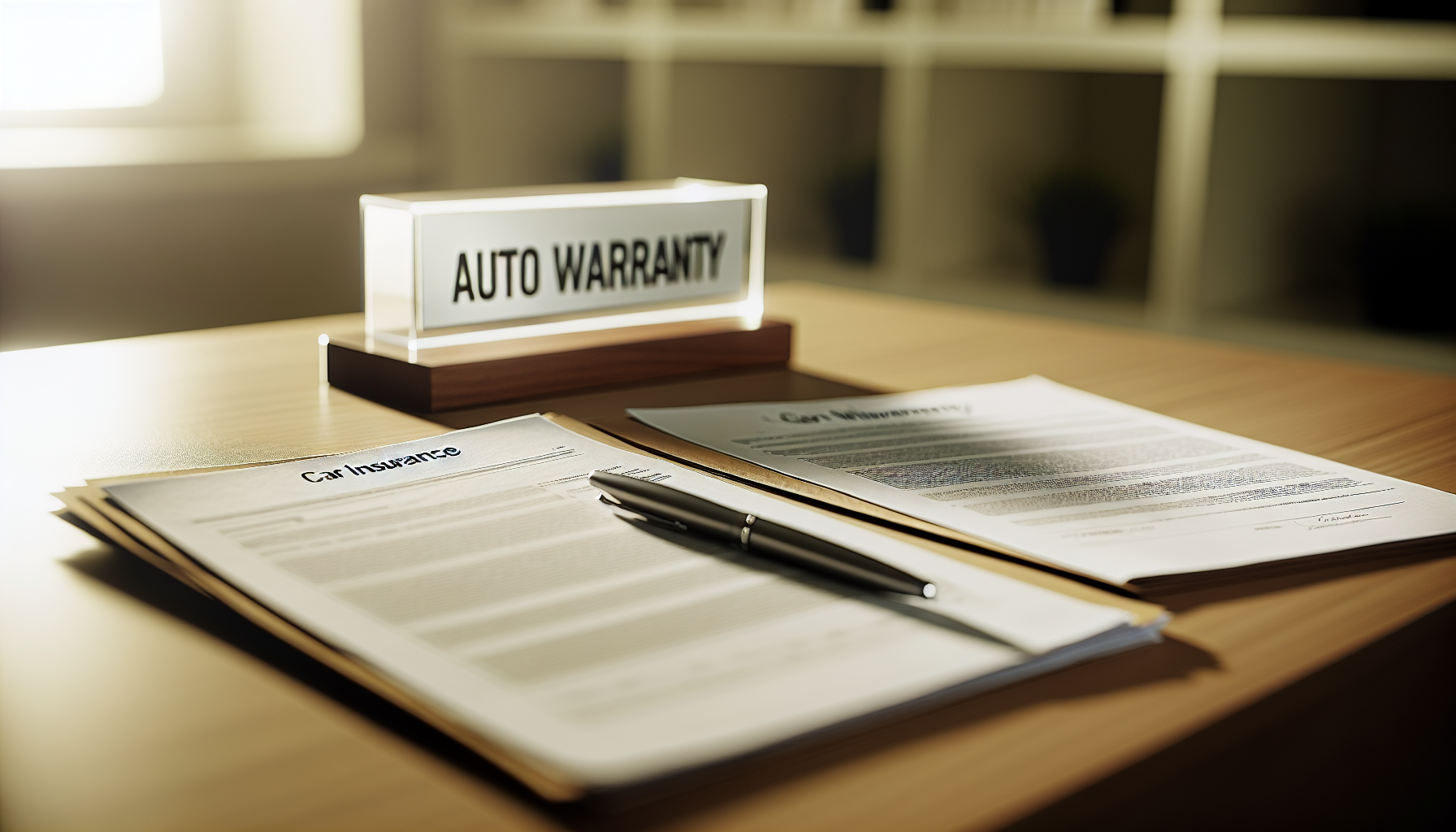What’s the difference between auto warranties and insurance? Simply put, warranties cover vehicle malfunctions and defects during a specific period, while insurance offers financial aid in accidents or theft. This piece will help you navigate these crucial forms of vehicle protection, highlighting when and how each applies to you and your car.
Key Takeaways
- Auto warranties and car insurance offer different types of protection; warranties cover vehicle defects and malfunctions, while insurance covers accidents, theft, and personal liability.
- Car insurance is legally required in most states and offers broader financial protection than warranties, including liability and collision coverage, while warranties typically exclude routine maintenance and wear-and-tear items.
- The costs associated with extended warranties and insurance differ; warranties have premiums based on several factors, whereas insurance policies involve deductibles, affecting the out-of-pocket costs for policyholders.
Navigating Coverage Choices: Understanding the Difference Between Auto Warranties and Insurance

Ever heard the phrase ‘apples and oranges’? That’s precisely what car warranties and auto insurance are – two distinct forms of financial protection for your vehicle. Auto warranties are contractual promises that cover certain vehicle defects or malfunctions for an agreed period after purchase. They are regulated on a state-by-state basis in the U.S and are not mandated by law.
On the other hand, car insurance is a legal requirement in most areas. It provides financial protection against accidents and damages resulting from collisions. So, while your car warranty has your back for mechanical breakdowns, car insurance steps in for:
- collision-related repairs
- damage caused by theft or vandalism
- medical expenses for injuries sustained in an accident
- legal fees and court costs if you’re sued as a result of a car accident
Introduction
The difference between warranties and insurance is key when shopping for a new or used car, as it affects the kind of financial protection a vehicle owner will receive. Auto warranties, often included in the purchase price, offer coverage for replacement parts or repairs within a specified time frame due to manufacturing defects.
Insurance policies, however, offer more comprehensive protection. These policies cover financial protection against incidents like collisions, theft, or natural disasters. They also provide liability and damage coverage from a wider variety of causes.
Unpacking Auto Warranties and Insurance: A Comparative Overview

Allow us to delve further into the intricate details of auto warranties and insurance. A car warranty is a contractual promise by the manufacturer to fix certain defects or malfunctions for a set period after purchase. These warranties typically cover non-collision-related mechanical issues. One common type of car warranty is the manufacturer’s warranty, which is provided directly by the car manufacturer.
Car insurance, on the other hand, provides financial protection against accidents and other damages resulting from collisions, which is why choosing from various car insurance companies is crucial.
The Scope of Auto Warranty Coverage
Auto warranties cover a wide range of components in your vehicle. They generally cover major powertrain components, including the engine, transmission, and drivetrain, as well as other mechanical issues such as engine or steering problems. They commonly include the fuel system, gearbox, clutch, steering mechanisms, brakes, and electrical systems.
However, keep in mind that warranty coverage typically does not include routine maintenance and wear-and-tear items like tires and brake pads. Coverage may also be negated if the vehicle is not serviced at required intervals or if issues arise from improper maintenance.
The Breadth of Car Insurance Protection
Car insurance, in contrast, offers comprehensive protection against a wide array of circumstances. Liability coverage, required by law in most states, covers both bodily injury and property damages that the insured may cause to others. This insurance includes bodily injury liability, covering medical expenses resulting from an accident, and property damage liability, covering repair costs to other vehicles and properties.
Additionally, many states require personal injury protection (PIP) or medical payments coverage (MedPay). These coverages pay for the medical expenses of the policyholder and passengers after an accident, irrespective of who is at fault. Uninsured motorist coverage takes effect when the policyholder is involved in an accident with an uninsured driver, providing financial protection for ensuing expenses.
Financial Safeguards: Extended Warranties vs. Insurance Policies
Extended warranties and mechanical breakdown insurance policies serve as financial safeguards in different scenarios. Extended warranties cater to mechanical breakdowns, covering costs for parts and labor due to manufacturing defects or specific car parts issues. They can be offered by manufacturers or third parties and are extendable beyond the initial warranty period.
A car insurance policy addresses a wider array of circumstances, including:
- Liability for property damage
- Collision coverage for collisions
- Comprehensive coverage for events like theft or fire
- Medical expenses
It’s worth noting that filing claims with car insurance can lead to higher future premiums, especially if the policyholder is found at fault, while warranty claims usually do not influence upcoming warranty expenses.
Calculating Costs: Premiums and Deductibles Decoded
Decoding the costs involved is a fundamental part of understanding warranties and insurance. Extended warranty providers calculate premiums based on multiple factors, such as:
- Coverage type
- Deductible options
- Vehicle details like make and model, age and mileage
- Specific terms of the service contract
The total cost of an extended warranty may vary, ranging from 6% to 24% of the product’s price.
On the other hand, in car insurance policies, deductibles play a crucial role. The policyholder is responsible for paying an out-of-pocket amount before the insurer covers the remaining costs for damages within the policy. Deductibles in warranty plans can significantly impact the cost borne by consumers, with options ranging from zero deductibles to fixed deductible amounts.
Selecting a Provider: What to Look for in Extended Warranty Providers and Insurance Companies
Choosing an extended warranty provider or insurance company is a significant decision. Reputable extended warranty providers are distinguished by their track record of excellent customer service and prompt claims processing, as well as customer advocacy and dedicated support handling claims dissatisfaction. It is beneficial to check customer reviews or ratings to gauge a provider’s service quality and customer satisfaction levels.
Moreover, providers that offer a range of customizable plans allow customers to personalize warranty coverage to match specific needs and vehicle conditions, enhancing the overall value provided by a vehicle service contract. When selecting a provider, compare the prices and coverage options to find the best deal, and ensure transparency to avoid hidden fees.
Added Perks: Roadside Assistance and Rental Car Reimbursement
What if we told you that some warranty packages and insurance policies come with additional perks? Roadside assistance is one such benefit, which can be accessed either through membership programs or included with auto insurance policies. Some car warranty packages offer roadside assistance, including services such as towing, battery recharging, and flat tire repair.
Many insurance policies also offer rental reimbursement coverage to cover car rental costs while the insured vehicle is being repaired; this is a coverage that might not always be offered by auto warranties. So, whether it’s a flat tire or car breaks, these added perks ensure that you aren’t left stranded!
Legalities and Obligations: What’s Required by Law?
Understanding the legalities surrounding car insurance and warranties is of paramount importance. Car insurance is a mandatory legal requirement in most states. Most states require a minimum amount of car insurance coverage that includes bodily injury liability per person and per accident, as well as property damage liability. However, exceptions exist where car insurance may be optional for remote residents, or opting out of insurance can incur a fee.
On the other hand, auto warranties are not mandated by law. They are regulated differently across states, and cars must generally be below a certain age and mileage to be eligible for a warranty.
The Impact of Vehicle Age and Condition on Coverage
The age and condition of your vehicle significantly impact your coverage. With warranties, cars must generally be below a certain age and mileage to be eligible. The age of a vehicle is a limiting factor for extended warranty eligibility, often capped at a certain number of years. Vehicle mileage can affect the availability and extent of extended warranty coverage; high-mileage vehicles may have more limited options.
Extended warranties usually exclude pre-existing conditions, which may require an inspection to determine before coverage is granted. As a car ages, extended warranties may feature more exclusions and enforce stricter terms.
Older, higher-mileage vehicles are more likely to experience mechanical failures. This is one reason why extended warranties for them tend to be more expensive. Older vehicles may have higher insurance rates, despite providing less coverage in comparison to newer vehicles. This is due to the increased risk of maintenance and repair for older vehicles.
Making Claims: The Process for Warranties and Insurance
The process of making claims for warranties and insurance involves several steps. To file an auto warranty claim, policyholders need to contact the provider, provide proof of maintenance, and take the vehicle to an authorized repair facility, with some warranties requiring pre-authorization for repairs. There are coverage limits on warranties which may dictate if the owner pays out of pocket, and specific repair or parts usage guidelines that must be followed.
Car insurance claims processes typically involve reporting the incident to the insurer and police, providing evidence and documentation, and working with an insurance adjuster to assess damages. Warranty claims may require more time for verification and defect assessment, while insurance claims involve adjusters and could be settled through direct payouts to policyholders or repair shops.
Personalizing Your Protection: Tailoring Coverage to Your Needs
The decision to choose the right coverage for your vehicle is a highly personal one. When selecting an extended car warranty, choose a coverage type that matches your vehicle’s reliability and expected service needs, considering its age and mileage. Tailor the length of your extended car warranty to correspond with your intended duration of vehicle ownership, taking into account your typical driving patterns and vehicle usage.
Review and compare costs for different extended car warranty options, taking into account your vehicle’s specifics and the compatibility of payment structures with your budgetary constraints. By personalizing your extended car warranty coverage, you ensure that your vehicle gets the coverage it needs without breaking the bank.
The Role of Gap Insurance in Your Coverage Strategy
Ever heard of gap insurance? It’s an optional coverage that assists in paying off an auto loan if the car is totaled or stolen and the owner owes more than the car’s depreciated value. If a car is declared a total loss, gap insurance covers the difference between the vehicle’s actual cash value and the remaining balance on the financing or lease agreement.
For drivers who finance or lease their vehicles, particularly when less than a 20% down payment is made, the loan term exceeds 60 months, or the vehicle is leased, gap insurance is vital to prevent financial strain due to insurance payout gaps. It can be purchased from auto insurers or car dealerships, with insurance companies generally offering more affordable rates.
Summary
Navigating the world of auto warranties and car insurance can seem daunting, but with the right knowledge, it becomes manageable. Whether it’s understanding the differences between warranties and insurance, deciphering costs, selecting a provider, or learning about additional perks, every aspect is crucial. Remember, personalizing your protection based on your vehicle’s needs and usage is key. Armed with this information, you’re now ready to hit the road with the right coverage!
Frequently Asked Questions
What is the difference between car warranty and insurance?
The main difference between car warranty and insurance is that a car warranty covers repair costs due to malfunctions, while car insurance protects a vehicle after an accident. Car warranties focus on mechanical breakdowns and provide financial protection, whereas car insurance covers medical bills and repair costs after a car wreck.
What factors influence the cost of extended warranty premiums and insurance deductibles?
The cost of extended warranty premiums and insurance deductibles is influenced by factors such as coverage type, deductible options, vehicle details like make and model, age, mileage, and the specific terms of the service contract.
What are the legal requirements related to car insurance and warranties?
Car insurance is a legal requirement in most states, while auto warranties are not mandated by law but are regulated differently across states. It’s essential to understand the specific regulations in your state to ensure compliance.





